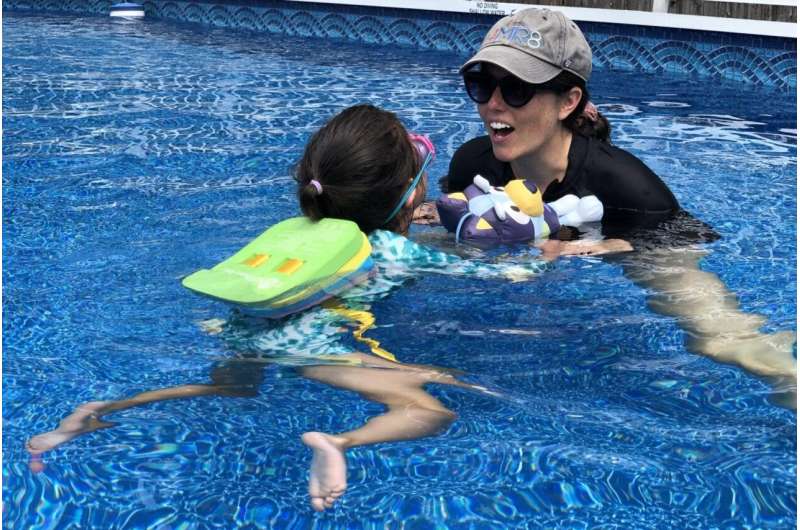This article has been reviewed according to Science X's editorial process and policies. Editors have highlighted the following attributes while ensuring the content's credibility:
fact-checked
trusted source
proofread
Occupational therapist devises inclusive adaptive swim lessons for autistic children

When Marykate Galluzzo was 16, she taught swim lessons at a community pool, and got offered a chance to give a private lesson to a young boy—a welcome opportunity because it meant more money.
But the boy had autism, and she had no idea how to help him learn to swim—he was clearly terrified of the water and had difficulty communicating. "I just remember feeling so overwhelmed and defeated, because I had no idea how to do this, and there was no one who could help me," she says.
Now Galluzzo, AG21, AG22, has developed a curriculum for teaching adaptive swimming lessons to kids with a variety of differences and disabilities. It's part of her work as an occupational therapist, which is about "helping individuals be able to engage in meaningful activities in their daily lives," she says.
Her Sunfish Method, which she developed as part of her doctoral work in the Department of Occupational Therapy at Tufts, is available online.
Some 400 young children drown each year in swimming pools in the U.S., and Galluzzo says the risk is much higher for kids with disabilities.
"Teaching this population is so important—it's about reducing the risk of drowning and saving lives," says Galluzzo, who works as a pediatric occupational therapist, mostly with autistic children, at South Shore Hospital. In her spare time, she also runs South Shore Sunfish, which offers private at-home swim lessons and adaptive swim instruction, and mentors Tufts doctoral students in occupational therapy.
Tufts Now spoke with Galluzzo recently about the best ways to teach swimming to kids with differences and disabilities—and everyone else.
What are adaptive swimming lessons? What makes them different from regular swimming lessons?
With classic swimming lessons, we're going to start teaching the kids to blow bubbles in water, to kick and reach and pull, and back float. But with adaptive lessons, you are changing it to meet the child's individual needs.
Sometimes you pull out pictures to show them what it's going to look like, demonstrate for longer what they're going to do, or engage them in more play-based swimming lessons. You're really changing what you're doing to meet the child's individual needs.
It's really about flexibility—learning to meet the child where they're at, as well as talking to parents, because they're the experts on their children.
What are some things to do for kids to get them ready to learn to swim?
One thing is to read books about swimming lessons, to give them an idea of what might happen in the swimming lesson. Another is getting the child used to blowing bubbles and getting their faces wet in the bathtub, even with a washcloth.
A lot of these children are very sensitive, especially in their facial area. For kids with sensory differences, practicing in the bathtub getting their ears, eyes, and nose wet can help a lot in preparation for swimming lessons.
Many kids are especially sensitive to having water coming into their ears, as well as being on their backs in water, so I have them practice laying on their back in the bathtub.
Another thing you can do is play "swimming lessons" at home and pretend to be the swim instructor and the student, while talking through what might occur during the swimming lesson and reinforcing that "we might get our faces wet and that's OK."
What are some general approaches to teaching swimming that are adapted for kids with special needs?
One great example is about water safety, such as asking to get into the pool. For a lot of our kiddos who are non-speaking, we use visuals to help teach them the rules of the pool, like first needing to find a swimming buddy before getting into the pool.
They can point to a picture indicating that they want to go swimming—it's important for them to know that they can't swim alone. We use what we call a swimming pass, with a little fish on it. The one with a green fish means that they can go in the pool, but if it's red, they can't go in the pool. That can be used with any child as well, of course.
Is there an example of a kid who you've taught who overcame a lot of resistance and now is comfortable in water?
I had an eight-year-old child who came to me two years ago, and he was so terrified of water. He couldn't even stand in the shallow end of a pool. Our first swimming lesson, he spent the entire time running around the pool—he could not get himself to even go near it.
We had to build a relationship of trust. After weeks of us playing games outside the pool, talking about the pool, me bringing out toys from the pool, I eventually was able to carry him into the pool myself.
He held onto me for a dear life. We spent some time just sitting in the pool together, me just holding him and talking to him and playing with him in the pool. Eventually, I was able to get him to get himself onto a flotation device.
After all of this time and effort, I saw him last week and he was able to swim independently on that flotation device, as well as walk around the pool by himself in the water and blow some bubbles, which is a huge change for him. He was so proud of himself.
We have a lot of work to do, but he is now more comfortable and gets right into the pool. It really warms my heart seeing him.





















